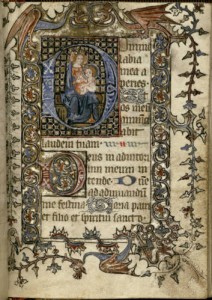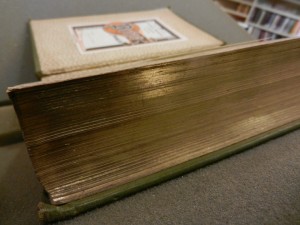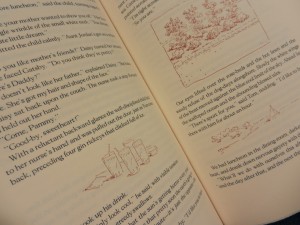
Whether it’s a rare book printing found at long last or piece of ephemera found in an archival collection by chance, those who visit the University of Houston Special Collections almost always find something they cannot wait to share with others. Here we celebrate what makes the University of Houston Special Collections so special–our Favorite Things.
This series is intended to shine a light on some of the most prized things we find here in Special Collections. Sometimes, however, we are reminded that the most special of all aren’t the objects that reside in our stacks, but the people who walk through our doors.
Not long ago I was witness to a special treat in the reading room. Headed out to our foyer desk to greet a patron, I was somewhat surprised when I encountered an elementary school-aged child. While a family member searched the general stacks, this young girl had intrepidly set out in search of older, rarer quarry.
I thought of all the amazing rare books in our collections, and tried to come up with the perfect example to share. Just before we went into the reading room to begin viewing materials, we were joined by Pat Bozeman, Head of Special Collections. Her mind quickly went to the Book of Hours, Use of Reims as a treat worthy of such a delightful and curious patron.
Watching the young researcher excitedly encounter this book was one of my favorite moments since joining the UH Libraries. It was a pleasure to watch and listen as Pat explained how the book was made and pointed out interesting details to a completely captivated child. And the girl’s reactions were a reminder of the wonder that these fantastic holdings have the power to elicit. There are lots of great things about working in the reading room, but there isn’t much that can top a child’s sincere “wow!”
The experience not only underscored the responsibility we here in Special Collections have for preserving and making accessible our cultural heritage, but was also a reminder of just how darn lucky we are to get to do it.
In addition to the over 7,000 linear feet of archival collections made available for study at the University of Houston Special Collections, we are also proud to offer over 100,000 rare and antique books for use in our reading room. Each month we will highlight a text from our collections and what makes it so special.
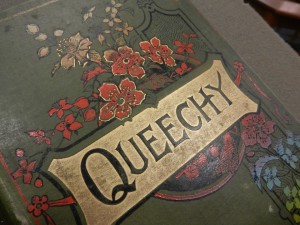
cover of Queechy / by Elizabeth Wetherell (Susan Warner)
Book of the Month: Queechy by Elizabeth Wetherell, as recommended by Julie Grob, Coordinator for Instruction at the University of Houston Special Collections.
Why So Special? “The pictorial cloth binding with a decoration of flowers that are multicolored,” writes Grob. “I’m a sucker for over-the-top publishers bindings from the 19th century, and this is one of the more elaborate in our collection.”
Originally published in 1852, Queechy was Susan Warner’s second novel, following her widely-translated debut, The Wide, Wide World (1850), also written under the pen name Elizabeth Wetherell. That book’s popularity gave Warner the distinction of being one of the most popular authors of a new nation still finding its literary voice. Our copy of Queechy is a glittering and gilded display that no doubt would have brought color to the cheeks of Warner’s Puritan forebearers. “Pictorial green cloth stamped in gold, red, blue, yellow and black. Edges gilt.”
Location: Pictures will not do this one justice. If you would care for a closer look, Queechy is available for study in the University of Houston Special Collections Reading Room, during our normal research hours. To spend some time with Fleda Ringgan as she crisscrosses the Atlantic, please request PS3155.Q4 1800z.
Many of the books featured in our current exhibition LGBTQI Literature: Celebrated Classics and Contemporary Works have been adapted into acclaimed movies and TV miniseries. From eighties costume drama Brideshead Revisited to this spring’s HBO film The Normal Heart, the stories of people who identify as LGBTQI have made for compelling drama on the big and small screen.
With the dog days of summer upon us, we recommend that you come view the exhibition, stop off for lunch or dinner at Eric’s Restaurant on campus, and then unwind at home with one of the following:
Those who are suffering from Downton Abbey withdrawal might enjoy the British miniseries Brideshead Revisited (1981), the tale of a friendship that develops between two young men at Oxford in the decade following WWI. Based on the novel by Evelyn Waugh, Brideshead… made a star of Jeremy Irons.
Desert Hearts (1985), directed by Donna Deitch and based on the novel Desert of the Heart by Jane Rule, is considered a classic of lesbian film. It centers on the realistic romance between divorcing housewife Vivian and casino worker Cay in Reno, Nevada.
Steven Spielberg directed The Color Purple (1985), an adaptation of the Pulitzer Prize-winning novel by Alice Walker. In it, main character Celie (played by Whoopi Goldberg) finds her life changed by an affair with the beautiful blues singer Shug.
Armistead Maupin’s Tales of the City (1993) was the first of three miniseries based on the writer’s popular books about life in a San Francisco apartment building in the 1970s. It starred a less well-known Laura Linney as the naive new tenant Mary Ann, and Olympia Dukakis as landlady Mrs. Madrigal. Various straight and gay neighbors with their own stories rounded out the characters.
The script for the two-part HBO production of Angels in America (2003) was adapted by Tony Kushner from his play about the AIDS epidemic in Reagan’s America. Angels… won 11 Emmy Awards including acting nods for Al Pacino as closeted conservative attorney Roy Cohn, and Jeffrey Wright as the compassionate nurse Belize.
Brokeback Mountain (2005) started out as a story by Annie Proulx in her 1999 collection Close Range: Wyoming Stories. The tale of two ranch hands who fall in love was adapted into a full-length screenplay by Larry McMurtry and his writing partner Diana Ossana. The Ang Lee-directed film starred Jake Gyllenhaal and the late Heath Ledger as the star-crossed Western lovers.
In May 2014, miniseries The Normal Heart debuted on HBO. Based on Larry Kramer’s 1985 play about activism during the early years of the AIDS crisis, it starred Mark Ruffalo and Julia Roberts, and will be released on DVD later this month.
LGBTQI Literature: Celebrated Classics and Contemporary Works will be on view on the 1st floor of MD Anderson Library through Sept. 26, 2014.
In addition to the over 7,000 linear feet of archival collections made available for study at the University of Houston Special Collections, we are also proud to offer over 100,000 rare and antique books for use in our reading room. Each month we will highlight a text from our collections.
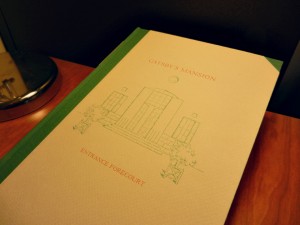
The Great Gatsby by F. Scott Fitzgerald, featuring artwork by Michael Graves
Book of the Month: The Great Gatsby by Francis Scott Fitzgerald; illustrated by Michael Graves (San Francisco : Arion Press, 1984)
Why So Special?: Required reading for just about every high school student as they come of age, Francis Scott Fitzgerald’s magnum opus is as American as Francis Scott Key’s offering. Routinely re-imagined every few decades on our collective silver screens to reflect our contemporary hopes and fears, Gatsby is often hailed as the novel on the subject of the American Dream, as amorphous an idea as that remains, full of all of our longing, anguish, confusion, desire, and “romantic readiness.” From Francis Cugat’s cover (commissioned and completed in the impatient haste of Scribners, seven months before the novel would even be ready–those eyes floating in the night, hinting at the enveloping darkness amid the carnival and light), to the sheer audacity and imagination of one James Gatz (convinced he cannot only reinvent himself of his own design, but he can will time to his bidding should he simply desire it enough), and on through the final words of the narrative, crystallizing our longing for and obsession with the illusory and the intangible (“So we beat on, boats against the current…”), The Great Gatsby has remained uniquely American.
Sometimes deceptively so.
For some it remains a pseudo-documentary of what Fitzgerald christened as “The Jazz Age,” The Roaring Twenties, “the most expensive orgy in history,” an American decade that found no proper suitor throughout her flirtations, and decided to stay on for the remainder of the century. To others it is a love story that sees desire run amok as it flies too close to a blazing white sun. Still others would present it as a cornerstone for the so-called “New York City novel,” an homage and tragic love story for Our New Paris; a story of The City that does not simply resign itself to the towering icons and alleyways of Manhattan, but also peers back behind the kitchen curtain windows of Long Island, revealing a complex web work of symbiotic and predatory class relations.
But Nick Carraway, our faithful and reliable narrator, would insist it has nothing to do with the New World’s metropolitan jewel, after all. He reflects on his “middle-west,” against the backdrop of that fateful summer of 1922:
That’s my middle-west–not the wheat or the prairies or the lost Swede towns but the thrilling, returning trains of my youth and the street lamps and sleigh bells in the frosty dark and the shadows of holly wreaths thrown by lighted windows on the snow. . . I see now that this has been a story of the West, after all–Tom and Gatsby, Daisy and Jordan and I, were all Westerners, and perhaps we possessed some deficiency in common which made us subtly unadaptable to Eastern life.
If the story of the American Dream is not rooted in the narrative of the so-called New World in the last handful of centuries leading up to that frenetic decade, full of all their blood and loss, then from where else does it originate? As if to underscore the point, it finally occurs to Nick while flailing about for his lost Eden at the tale’s conclusion, preparing to flee the corruption of the east, bound for his old, familiar home, he sprawls out on the Long Island beach and broods “on the old unknown world”:
And as the moon rose higher the inessential houses began to melt away until gradually I became aware of the old island here that flowered once for Dutch sailors’ eyes–a fresh, green breast of the new world. Its vanished trees, the trees that had made way for Gatsby’s house, had once pandered in whispers to the last and greatest of all human dreams; for a transitory enchanted moment man must have held his breath in the presence of this continent, compelled into an aesthetic contemplation he neither understood nor desired, face to face for the last time in history with something commensurate to his capacity for wonder.
And so it has remained for all of us, as we come of age in the New World, chasing the siren songs of phantasmal green lights hovering on our horizons.
This Arion Press imprint is limited to 400 copies and features the artwork of Michael Graves, of the New York Five fame, on the binding and throughout Fitzgerald’s prose. The text hops and springs over and around the illustrations of Graves, not unlike that running Buchanan lawn, “jumping over sun-dials and brick walks and burning gardens.” This particular volume also includes the signature of Graves below the colophon. Types used are Goudy Light and Piehler Capitals and the paper is French mould-made Rives, with a deckle edge.
Location: Available for study in the University of Houston Special Collections Reading Room (sorry, no beach reading with this one), Monday through Friday 9am-5pm. Bibliophiles or the simply curious should request call number PS3511.I9 G7 1984.
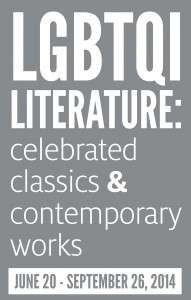
a new exhibit, “LGBTQI Literature: Celebrated Classics and Contemporary Works,” is now on display on the first floor of the M.D. Anderson Library
A new exhibit has opened on the first floor of the M.D. Anderson Library. “LGBTQI Literature: Celebrated Classics and Contemporary Works,” curated by our own Julie Grob, features fiction, poetry, memoirs, and plays written by and about people who are lesbian, gay, bisexual, transgender, queer, or intersex. Opening now to coincide with the annual Pride Houston celebrations, the exhibit serves as an excellent educational complement to the festivities marking historical milestones in the movement.
Tracing critical and popular literature from those days prior to Stonewall, the years following the so-called riots, through the dark days of the AIDS crisis, and on into contemporary pieces produced at the turn of the new century, “LGBTQI Literature” pulls from a number of distinct libraries available for study and research at the University of Houston Special Collections as well as a handful of pieces on loan from private collections. Prominently featured throughout the exhibit are texts from the Norma J. Lee Collection and the Edward Lukasek Gay Studies Collection, as well as works found in the Library of Cynthia Macdonald and the Kanellos Latino Literary Movement Book Collection. A cursory glance of highlights will show the likes of a 1928 first edition of Virginia Woolf’s Orlando: A Biography, Tony Kushner’s ever-popular Angels in America: A Gay Fantasia on National Themes, as well as an 1891 printing of Oscar Wilde’s, The Picture of Dorian Gray.
We invite you to come view the exhibit for yourself, explore the exhibit’s website for more information, or stop by the History Tent on June 28th at the Houston Pride Festival and Parade where our own Vince Lee, Archivist for Carey C. Shuart Women’s Archive and Research Collection, will be in attendance with more information and artifacts on display.
